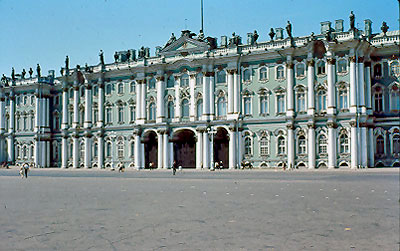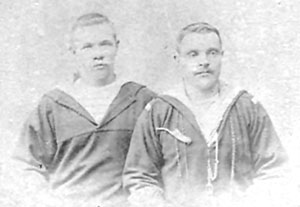
The Winter Palace, scene of the Bolshevik seizure of power in 1917
Ok, let's start with the fact that there were two revolutions in Russia in 1917, the February and October Revolutions. The first revolution toppled the Romanov dynasty and forced tsar Nicholas II to abdicate the throne on 2/15 March 1917. Nicholas' brother, Michael, declined the throne on 3/16 March 1917--both abdications were probably illegal--and a Provisional Government (PG) came into existence. It is a bit unclear if the PG was really a legal body, but then again no one asks such questions in the middle of a revolution. The period between the February and October Revolutions is often termed a time of "dual power," when the Provisional Government vied with the St. Petersburg Soviet of Workers' and Soldiers' Deputies for political control. While the PG might have had de jure political power, it was the Soviet that wielded de facto power in the capital. The second revolution occurred in October 1917 when the Bolsheviks overthrew the Provisional Government and seized power.
So, you might ask, were these revolutions in February, March, October or November 1917? The confusion arises from the Russian calendar in use in 1917, being twelve days behind the Western calendar used by the rest of Europe and the United States. So the February Revolution occurred in February according to the Russian calendar (but in March according to the Western calendar). The Bolshevik seizure of power took place on the night of 25/26 October (6/7 November according to the Western calendar). In the new Soviet state, Lenin ordered the abandonment of the old calendar to bring Russia in line with the rest of the world so the Soviets always celebrated the October Revolution in November.
Let me mention one other curious note here. After almost eighty years of making 6/7 November a great national holiday, an "against-all-odds-seizure-of-power-by-the-working-class-led-by-the-Bolshevik-party" holiday celebrated by communists the world over, the revolution is no longer officially celebrated as a holiday in Russia. What is left of the Russian communist party celebrates a bit, but any public demonstrations, etc are frowned upon!

Kronstadt sailors
Kronstadt was Imperial Russia's main naval base on the Baltic Sea just outside of St. Petersburg. It was also a hotbed of radical political activity during World War I. The sailors became the Bolshevik party's "shock troops" in 1917 and were always to be relied on to support Lenin, either in the abortive "July Days" uprising, the suppression of the "Kornilov Rebellion" in September or the seizure of power in October.
Both the February and October revolutions were rather simple, quick, bloodless affairs. For example, in February there was labor unrest and strikes in St. Petersburg. In the face of food shortages, some women rioted. Some more workers went on strike in support of them, and then some more workers. The police lost control of the situation, and then some troops refused to fire on the women and strikers. Suddenly the garrison refused to obey any orders from the government. The tsar abdicated, the PG took over, and wow!, you had a revolution. October was not much different. Under the cover of darkness, some Bolsheviks infiltrated the Winter Palace and convinced the guard there that there was no point in defending the Provisional Government. The Cruiser Aurora fired a cannon shot as a "warning signal," although I am not sure who was being warned, and some more Bolsheviks entered the Winter Palace and marched upstairs to arrest the ministers of the PG who were dumb enough to still be in the building. Bow! You had another revolution take place.
Easy enough, but the real bloodshed came in the ensuing four years of: war with Germany, war with Poland, internal civil war (along class, ethnic and religious lines) between "Whites" and "Reds"--although that is an extremely simplistic formulation--and foreign intervention. We can only guess the total cost in human life for all that on the order of maybe ten million people.

- Aleksandr Blok, The Twelve (1918); his vision of the apocalypse.
- Marc Ferro, The Russian Revolution of February 1917 (1972)
- Tsuyoshi Hasegawa, The February Revolution, Petrograd 1917 (1981)
- Alexander Rabinowitch, Prelude to Revolution: The Petrograd Bolsheviks and the July 1917 Uprising (1968)
- John Wheeler-Bennett, The Forgotten Peace: Brest-Litovsk, March 1918 (1939)
- William Henry Chamberlin, The Russian Revolution, 1917-1921, 2 vols. (1935)
- Stephen Cohen, Bukharin and the Bolshevik Revolution: A Political Biography, 1888-1938 (1973)
- Victor Chernov, The Great Russian Revolution (1936)
- Aleksandr Kerenskii (1881-1970), The Catastrophe: Kerensky's Own Story of the Russian Revolution (1927)
- Anton Denikin, The White Army (1930)
- Allan Wildman, The End of the Russian Imperial Army: The Old Army and the Soldiers' Revolt (March-April 1917) (1980)
- Leon Trotsky, The History of the Russian Revolution, 3 vols. (1932)
- Orlando Figes, A People's Tragedy: A History of the Russian Revolution, 1891-1924 (1996)
- Paul Avrich, Kronstadt 1921 (1970)
- Israel Getzler, Kronstadt, 1917-1921: The Fate of a Soviet Democracy (1983)
- Some lectures by the late Professor Michael Boro Petrovich are available on the web: February Revolution, Dual Power, and October Revolution (sometimes they work; sometimes they don't).
- There are some excellent websites devoted to the Russian revolutions and civil war, including:
- Some Remarks:
- Professor Gerhard Rempel, Western New England College, The Revolution of 1917
- Daniel Kaiser, The Russian Revolution of 1917: A Guide to Electoral Behavior in Revolutionary Russia
- Valentine M. Smith, Three Men in Russia: Marye, Robins, and Francis, 1914-18
- Ray Cunningham, Factory committees in the Russian Revolution
- Heather-Noël Schwartz, Makhnovists & The Russian Revolution
- Documents:
- Internet Modern History Sourcebook: Russian Revolution
- The Avalon Project's The November Revolution The Bolshevik "Coup d'Etat" November 7, 1917
- Letter from Lenin authorizing the hanging of kulaks opposed to the Bolsheviks, 1918 (used to be available on the web)
- B V Avilov's speech at the 2nd All-Russia Congress of Soviets (26 October 1917)
- SR appeal for opposition to the Bolsheviks' seizure of power, 26 October 1917
- 15 March, 1917 Abdication of Nicholas II
- 3 March, 1918: The Peace Treaty of Brest-Litovsk
- 15 September 1919, Lenin Letter to A M Gorky on Soviet policy towards the intelligentsia
- April Theses
- 1918 Constitution
- 29 May 1918, Council of People's Commissars Address to the population on the struggle against famine
- 1918, To the Toiling Masses Of France, Britain, America, Italy & Japan, Appeal of the Russian Workers' and Peasants' Soviet Government
- July 1919, To all! Appeal of the Socialist-Revolutionary Party Central Committee (no longer available)
- December 1920, Antonov, The Programme of the Union of Toiling Peasants (Tambov)
- 4 March 1920, Kropotkin - Letter to Lenin on starvation amongst worker
- Alexandra Kollontai Memoir on 1917
- America's Secret War, American intervention in the Russian Civil War, 1918-1920
- The Truth about Kronstadt. Also on the Kronstadt Uprising
- Russian Revolution Posters
- Some Lenin speeches on gramophone records (mp3 files with English translation)